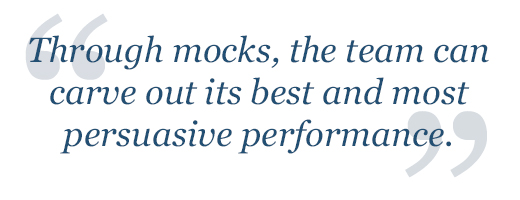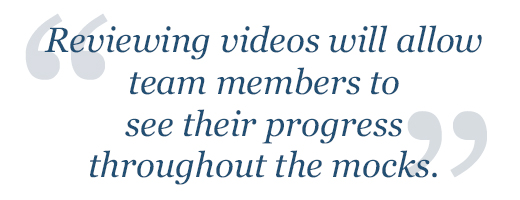Mock meetings are an important component of every Advisory Committee preparation. Organized to replicate an actual AdComm meeting in both process and performance, they provide the team with outside perspectives on company strategy, messages, and data. They serve as a first external audience, an audience whose responses help the team revise and refine its performance. Through feedback from mock panelists and analyses of strengths and weaknesses, the team will learn how to make the core presentation and Q&A session responses more effective.
During a six-month preparation, it is helpful to hold at least three or four mock meetings. The first should be scheduled early enough in the preparation to provide the team an assessment on which to base revision. Subsequent mocks should be scheduled to allow enough time for the team to evaluate and incorporate feedback before testing it on the next set of panelists. Such an iterative process helps the team accomplish its mission of aligning messages and addressing issues with accuracy and consistency.
Each mock should be conducted as though it were an actual AdComm. A chair should direct the proceedings, and the agenda should reflect a typical AdComm. All team members should attend – moderator, presenters, designated responders, slide retrieval crew, and those who perform support functions essential to the AdComm.
Like actors in a play, team members need dress rehearsals to get ready for opening night. Through mocks, the team can carve out its best and most persuasive performance.
Mirroring the AdComm allows the team to understand what it's like to present to a critical audience and respond to questions under pressure. It presents opportunities for the team to better understand the process, each knowing and performing his or her part in harmony with all others.
In order to best help the team understand who its audience will be on the day of the meeting, the mock panel should reflect the expertise and manner of the people on the standing Committee. Populating each mock with different panelists maximizes the quality and quantity of feedback available to the team.

Through observation of and interaction with mock panelists, team members will be able to get a feel for the concerns, comment and question content and style, and thought processes of the people serving on the actual Committee. The team can then fold that knowledge into revisions of its presentation and responses.
Essential to selecting panelists who will be the most help to the team is profiling. Constructing a profile and performing audience analysis early in the preparation process allows the team to better identify potential mock panelists who mirror the Committee.
First of all, hold the mock out of the office. Arrange the room's lay-out to be as close as possible to the actual meeting room. There should be space for the Sponsor's team, AV team and equipment, and a U-shaped table at which the mock panelists will sit. Use the slide equipment that will be used for the Advisory Committee meeting, and seat people throughout the room to make sure slides are visible and voices can be heard.
All participants should stay in role until the feedback session, mimicking the actual meeting (even if someone on the team knows a mock panelist).
Finally, record each mock. Reviewing it later provides an opportunity for the team to critique its own performance.
Obtaining and Using Feedback from the Panel
After the presentation and Q&A session, the chair of the meeting should facilitate a feedback session with the panelists, asking them for critical comments about the presentation, Briefing Document, and question responses. The chair may also ask for feedback about slides, delivery style, or any matter of concern.
Although the mock will be recorded, someone from the team should be assigned to capture comments made during this session. That list will serve as a sort of high-level outline of concerns, ensuring that nothing major is overlooked but also facilitating a prioritization of issues to be resolved.

During later debriefing, the team must assess those comments or suggestions and then choose which ones to incorporate into the presentation, responses, and slide deck. It should discuss any key concerns or themes that emerged from panelist feedback and determine whether and how to address them. It should also capture any new questions and appropriate responses in the Q&A books.
In addition to reviewing the suggestions made by panelists, team members should watch the video of the mock session to evaluate presentations and responses for clarity and persuasive delivery. They should assess speed and accuracy of slide retrieval. They should examine slides to ensure that each provides persuasive data and is well-designed. They should address any additional areas in need of revision.
An additional advantage to reviewing the videos is that team members will be able to see their progress from the first mock to the last. And that, really, is the ultimate value of mock panels – progress, the kind that not only improves performance but translates that improvement into the confidence that the team is excellently prepared.





